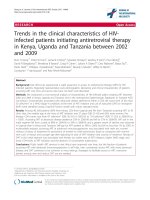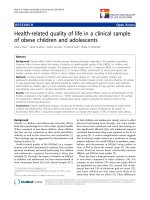Prevalence and trends in overweight and obesity in threecross sectional studies of British children, 1974-94
Bạn đang xem bản rút gọn của tài liệu. Xem và tải ngay bản đầy đủ của tài liệu tại đây (220.99 KB, 3 trang )
Primary care
Prevalence and trends in overweight and obesity in three
cross sectional studies of British children, 1974-94
Susan Chinn, Roberto J Rona
Department of
Public Health
Sciences, King’s
College London,
London SE1 3QD
Susan Chinn
reader in medical
statistics
Roberto J Rona
professor
Correspondence to:
S Chinn
BMJ 2001;322:24–6
Abstract
Objectives To report trends in overweight and
obesity, defined by new internationally agreed cut-off
points, in children in the United Kingdom.
Design Three independent cross sectional surveys.
Setting Primary schools in England and Scotland.
Participants 10 414 boys and 9737 girls in England
and 5385 boys and 5219 girls in Scotland aged 4 to
11 years.
Main outcome measures Prevalence and change in
prevalence of overweight and obesity, as defined by
the international obesity task force, in 1974, 1984, and
1994, for each sex and country.
Results Little change was found in the prevalence of
overweight or obesity from 1974 to 1984. From 1984
to 1994 overweight increased from 5.4% to 9.0% in
English boys (increase 3.6%, 95% confidence interval
2.3% to 5.0%) and from 6.4% to 10.0% in Scottish
boys (3.6%, 1.9% to 5.4%). Values for girls were 9.3%
to 13.5% (4.1%, 2.4% to 5.9%) and 10.4% to 15.8%
(5.4%, 3.2% to 7.6%), respectively. The prevalence of
obesity increased correspondingly, reaching 1.7%
(English boys), 2.1% (Scottish boys), 2.6% (English
girls), and 3.2% (Scottish girls).
Conclusion These results form a base from which
trends can be monitored. The rising trends are likely
to be reflected in increases in adult obesity and
associated morbidity.
Table 1 Published cut-off points for body mass index for
overweight and obesity by sex between 4 and 12 years of age
Body mass index 25
Body mass index 30
Age (years)
Boys
Girls
Boys
Girls
4
17.6
17.3
19.3
19.1
4.5
17.5
17.2
19.3
19.1
5
17.4
17.1
19.3
19.2
5.5
17.5
17.2
19.5
19.3
6
17.6
17.3
19.8
19.7
6.5
17.7
17.5
20.2
20.1
7
17.9
17.8
20.6
20.5
7.5
18.2
18.0
21.1
21.0
8
18.4
18.3
21.6
21.6
8.5
18.8
18.7
22.2
22.2
9
19.1
19.1
22.8
22.8
Participants and methods
9.5
19.5
19.5
23.4
23.5
10
19.8
19.9
24.0
24.1
The national study of health and growth, which started
in 1972, included 22 English areas in 1974, 1984, and
1994, six Scottish areas in 1974, and 14 Scottish areas
in 1983-4 and 1993-4. All white children from the
national study of health and growth were eligible for
10.5
20.2
20.3
24.6
24.8
11
20.6
20.7
25.1
25.4
11.5
20.9
21.2
25.6
26.1
12
21.2
21.7
26.0
26.7
Introduction
Recently the need for estimates of overweight and
obesity in children to assess preventive measures,
monitor secular trends, and identify high risk groups
has been emphasised.1 2 There has been a lack of consensus over the definitions, but internationally based
cut-off points have now been published.3 On the basis
of these cut-off points we report prevalence and secular trends in overweight and obesity from 1974 to 1994
in white children in the United Kingdom.
24
our study. The samples included too few non-white
children for useful analysis; ethnic minority groups
were included in a separate inner city sample not
reported here. We chose to study (a) 1994 because this
was the final year of the national study, (b) trends from
1984 to 1994 in weight for height because these data
have been reported,4 and (c) 1974 because this was representative of the earlier years. Areas were chosen by
stratified random sampling for England and Scotland
separately, with weighting towards poorer areas. If a
school needed to be replaced a comparable school was
chosen in the same area when possible or from
another area in the same stratum.5
When the national study of health and growth
began in 1972 a system of ethical committees for community based studies had not been established, but the
coordinators at the time obtained ethical approval
from St Thomas’s Hospital medical ethics committee.
Participation of schools was agreed with the health and
education authorities and head teacher in each area.
Parents were notified of the study in advance and were
able to withdraw their child.
Height was measured on a Holtain stadiometer to
the last 0.5 cm in 1974 and to the last 0.1 cm in 1984 and
1994; 0.25 cm or 0.05 cm was added as appropriate.
Weight was recorded to the last 100 g with a mechanical
Adapted from Cole et al.3
BMJ VOLUME 322
6 JANUARY 2001
bmj.com
Primary care
balance in 1974 and 1984 and electronic digital scales in
1994. Details have been given elsewhere.4
Body mass index was calculated as weight
(kg)/(height (m)2). Using linear interpolation between
the cut-off points for each six months of age we calculated the percentage of children who were overweight
or obese for each country, sex, and year. Children were
divided into three age groups, 4 to 6, 7 to 8, and 9 to 11
years. The definitions of overweight and obesity were
based on average centiles estimated to pass through
body mass index 25 and 30, respectively, at age 18.3
Table 1 shows the cut-off points for ages 4 to 12 years.
Table 2 Prevalence of overweight in children in 1974, 1984, and 1994 in England and
Scotland. Values are percentage overweight unless stated otherwise
Change in prevalence (95% CI)
1974
1984
1994
1974 to 1984
1984 to 1994
4139
3259
3016
4 to 6
6.8
4.6
7 to 8
6.2
5.7
5.4
−2.2 (−4.1 to −0.2)
0.7 (−1.2 to 2.7)
9.0
−0.5 (−2.5 to 1.6)
9 to 11
6.2
3.3 (0.8 to 5.7)
5.8
12.7
−0.4 (−2.2 to 1.4)
6.9 (4.4 to 9.4)
6.4
5.4
9.0
−1.0 (−2.1 to 0.1)
3.6 (2.3 to 5.0)
3871
3008
2858
English boys
No
Age (years):
Total
English girls
No
Age (years):
Results
Over 97% of children were measured in 1974 and
1984 and over 94% in 1994. Table 2 shows the
prevalence and changes in prevalence in overweight.
From 1974 to 1984 there was little overall change.
From 1984 to 1994 there was an overall increase in all
four groups of children: 3.6% in boys and 4.1% and
5.4% in English and Scottish girls, respectively. The
increase was greatest in the oldest age group, the
differences between age groups being significant in
English boys (logistic regression, test of interaction
P = 0.009). The prevalence reached nearly 20% in the
oldest Scottish girls in 1994. Table 3 shows the
prevalence of obesity, but this is relatively small and is
not shown subdivided as there is low power to detect
differences between age groups. A decrease in obesity
in boys occurred from 1974 to 1984 and an increase in
all groups from 1984 to 1994, with Scottish girls
having a final prevalence of 3.2%.
4 to 6
9.5
7.5
10.9
−2.1 (−4.6 to 0.4)
3.4 (0.7 to 6.1)
7 to 8
7.6
10.6
12.5
3.0 (0.3 to 5.6)
1.9 (−1.3 to 5.1)
9 to 11
Total
9.9
9.9
16.7
0.0 (−2.4 to 2.3)
6.9 (3.8 to 10.0)
9.1
9.3
13.5
0.3 (−1.2 to 1.7)
4.1 (2.4 to 5.9)
1172
2141
2072
Scottish boys
No
Age (years):
4 to 6
7.0
5.7
7.6
−1.3 (−4.5 to 1.9)
1.9 (−0.9 to 4.8)
7 to 8
4.2
6.4
8.0
2.2 (−0.8 to 5.3)
1.6 (−1.5 to 4.7)
9 to 11
5.0
6.9
13.4
1.9 (−0.7 to 4.6)
6.5 (3.5 to 9.5)
5.4
6.4
10.0
1.0 (−0.1 to 2.7)
3.6 (1.9 to 5.4)
1078
2105
2036
Total
Scottish girls
No
Age (years):
4 to 6
10.1
9.3
11.9
−0.8 (−5.0 to 3.4)
2.5 (−1.1 to 6.1)
7 to 8
7.0
11.3
15.1
4.2 (0.1 to 8.3)
3.8 (−0.4 to 8.0)
9 to 11
9.1
10.6
19.6
1.5 (−1.9 to 5.0)
9.0 (5.3 to 12.7)
Total
8.8
10.4
15.8
1.6 (−0.7 to 3.8)
5.4 (3.2 to 7.6)
Table 3 Prevalence of obesity in children in England and Scotland in 1974, 1984, and
1994
Discussion
No (%) of obese children
Although the prevalence of overweight and obesity in
children has been reported previously in the United
Kingdom and elsewhere, the results have always been
difficult to interpret as they have relied on the 85th and
95th centiles of reference or study based values or a
What is already known on this topic
Mean weight for height increased in children in
the United Kingdom from 1984 to 1994
Previously there were no agreed definitions of
overweight and obesity that could be used to
quantify the increase
Internationally agreed definitions have recently
been published
What this study adds
Prevalence of overweight was 5-6% in both 1974
and 1984 in white boys and 9-10% in white girls,
and it rose to 9-10% in boys in 1994, to over 13%
in English girls, and to nearly 16% in Scottish girls
The prevalence of obesity in children is low, but it
has increased substantially since 1984
Overweight in children is a serious public health
problem in Britain
BMJ VOLUME 322
6 JANUARY 2001
bmj.com
1974
1984
1994
1974 to 1984
1984 to 1994
English boys
58/4139 (1.4)
18/3259 (0.6)
52/3016 (1.7)
−0.8 (−1.2 to −0.4)
1.2 (0.6 to 1.7)
English girls
59/3871 (1.5)
38/3008 (1.3)
75/2858 (2.6)
−0.3 (−0.8 to 0.3)
1.4 (0.6 to 2.1)
Scottish boys
20/1172 (1.7)
19/2141 (0.9)
44/2072 (2.1)
−0.8 (−1.7 to 0.0)
1.2 (0.5 to 2.0)
Scottish girls
20/1078 (1.9)
38/2105 (1.8)
66/2036 (3.2)
−0.1 (−1.0 to 0.9)
1.4 (0.5 to 2.4)
preset excess level of relative weight.2 6 7 We have on
several occasions reported increases in weight for
height in children,4–8 but until now we have not
reported prevalence of obesity. Previously this information would have shed little light on the magnitude
of the problem as different studies have used different
definitions. The recently agreed cut-off points for overweight and obesity in children have given us the
opportunity to provide baseline information and,
uniquely, trends in overweight and obesity over a 20
year period.3 The data from the national study of
health and growth for 1990 formed the greater part of
the data for children aged 5 to 11 years in the United
Kingdom dataset, which contributed to the international standards.9 Our study gives an appropriate
base against which estimates from other studies in the
United Kingdom and elsewhere can be compared with
the same methodology.
Because of the reduced power of an analysis of a
dichotomous variable compared with an analysis of the
underlying continuous measure, the results do not show
a clear picture of the age group differences in the
increase in prevalence. An analysis of a weight for height
index, however, showed a clear trend of a greater
25
Primary care
increase in older age groups from 1972 to 1994, which
was particularly noticeable in Scottish children.8
Although debate over the cut-off points will
continue, this should not detract from the urgency of
tackling the problem of obesity. Our data indicate that
overweight and obesity on the basis of body mass index
have increased noticeably since 1984. Most studies have
shown poor prediction of adult obesity from child
assessments but a consistent positive correlation
between child and adult overweight and obesity.10 Rising
trends in children will almost certainly be represented in
later trends in adult overweight and obesity and
probably in an increase in associated adult morbidity.
We thank our colleagues in the study team, all parents, children,
and helpers in the study areas, and Professor Tim Cole for
supplying the international cut-off points in advance of their
publication.
Contributors: SC carried out all the analyses, wrote the first
draft of the paper, and is guarantor. RJR was the project leader
for the national study of health and growth and initiated and
participated in the writing of the paper.
Funding: The national study of health and growth was
funded by the Department of Health.
Competing interests: None declared.
1
Prentice AM. Body mass index standards for children. BMJ
1998;317:1401-2.
2 Reilly JJ, Dorosty AR, Emmett PM. Prevalence of overweight and obesity
in British children: cohort study. BMJ 1999;319:1039.
3 Cole TJ, Bellizzi MC, Flegal KM, Dietz WH. Body mass index in children
worldwide: cut-off points for overweight and obesity. BMJ
2000;320:1240-3.
4 Chinn S, Hughes JM, Rona RJ. Trends in growth and obesity in ethnic
groups in Britain. Arch Dis Child 1998;78:513-7.
5 Chinn S, Rona RJ. Trends in weight-for-height and triceps skinfold thickness in English and Scottish children 1972-82 and 1982-90. Paediatr Perinatal Epidemiol 1994:8:90-109.
6 Peckham CS, Stark O, Simonite V, Wolff OH. Prevalence of obesity in
children born in 1946 and 1958. BMJ 1983; 286:1237-42.
7 Troiano RP, Flegal KM, Kuczmarski RJ, Campbell SM, Johnson CL. Overweight prevalence and trends for children and adolescents. Arch Pediatr
Adolesc Med 1995;149:1085-91.
8 Hughes JH, Li L, Chinn S, Rona RJ. Trends in growth in England and
Scotland 1972 to 1994. Arch Dis Child 1997;76:182-9.
9 Cole TJ, Freeman JV, Preece MA. Body mass index reference curves for
the UK. Arch Dis Child 1995;73:25-9.
10 Power C, Lake JK, Cole TJ. Measurement and long-term health risks of
child and adolescent fatness. Int J Obes Relat Metab Disord 1997;21:507-26.
(Accepted 29 September 2000)
How women with a family history of breast cancer and
their general practitioners act on genetic advice in general
practice: prospective longitudinal study
Geertruida H de Bock, Christi J van Asperen, Josephine M de Vries, George C H A Hageman,
Machiel P Springer, Job Kievit
Correspondence to:
G H de Bock
continued over
BMJ 2001;322:26–7
This article is part
of the BMJ’s
randomised
controlled trial of
open peer review.
Documentation
relating to the
editorial decision
making process is
available on the
BMJ’s website
The most important risk factor for breast cancer,
besides advanced age, is a family history of breast cancer. General practitioners play an important role in
identifying women who are at increased risk of breast
cancer,1 especially women who are too young to be eligible for population screening. In a prospective longitudinal study with three years of follow up, we studied
women’s compliance with advice provided by their
general practitioner that was based on assessment of
genetic risk and whether this genetic advice was in line
with the advice of a clinical geneticist.
Participants, methods, and results
The women were patients at a primary healthcare centre
linked to a university in the Netherlands. The centre,
whose six general practitioners serve 11 500 patients,
uses only computerised medical records. This system
allows records of patients with specific risk factors and
Genetic advice given by clinical geneticist to general practitioner, based on relative risk
of breast cancer calculated for each woman, and advice given by general practitioner to
patient. Values are numbers of women
Relative risk and genetic advice of clinical geneticist
<2;
reassurance
2-3; surveillance†
>3; referral to
family cancer clinic
Total
Reassurance
19
0
0
19
Surveillance†
8
17
11
36
Referral to a family cancer clinic
0
0
8
8
27
17
19
63
Genetic advice given by general
practitioner*
Total
*All women received advice on breast self examination.
†Surveillance=annual palpation by the general practitioner and annual mammography.
26
diseases to be marked and selected. A total of 2000 of
the 2220 patients aged between 25 and 50 consulted
their general practitioner between April 1994 and July
1995, and of these 81 sought advice on their familial risk
of breast cancer.2 These women were subsequently
interviewed twice. In summer 1995, 67 of the 81 women
were interviewed about their family history of breast
cancer. A clinical geneticist reviewed each family history,
calculated a relative risk of breast cancer for each woman
(from < 2, representing a normal or slightly increased
risk, to >3, a highly increased risk) and gave genetic
advice to the general practitioner (table). The genetic
advice was in line with Dutch national guidelines as
developed in 1999-2000. In autumn 1995 the general
practitioners discussed this advice and the risk
assessment with each woman in a single consultation
(n = 63; four women had moved). In autumn 1998, 42 of
the women were asked about their reasons for their
compliance (or non-compliance) with the genetic advice
and with advice on breast self examination. Data on the
genetic advice given by the general practitioner to each
patient, the surveillance given by the general practitioner (annual palpation by the general practitioner
and annual mammography), and patients’ visits to family cancer clinics were extracted from the medical
records (n = 63). The medical ethics committee of the
Leiden University Medical Centre approved the study
protocol.
The clinical geneticist’s advice was not followed by
the general practitioner in 30% of the individual
consultations; the general practitioners advised surveillance more frequently than did the geneticist (table).
BMJ VOLUME 322
6 JANUARY 2001
bmj.com









